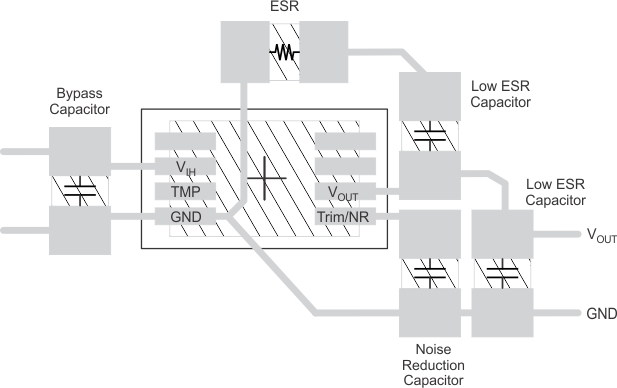SBOS471B April 2010 – June 2015 REF5020-EP , REF5025-EP , REF5040-EP , REF5050-EP
PRODUCTION DATA.
- 1 Features
- 2 Applications
- 3 Description
- 4 Revision History
- 5 Pin Configuration and Functions
- 6 Specifications
- 7 Detailed Description
- 8 Application and Implementation
- 9 Power Supply Recommendations
- 10Layout
- 11Device and Documentation Support
- 12Mechanical, Packaging, and Orderable Information
Package Options
Mechanical Data (Package|Pins)
- D|8
Thermal pad, mechanical data (Package|Pins)
Orderable Information
10 Layout
10.1 Layout Guidelines
- Place the power-supply bypass capacitor as closely as possible to the VIN pin and ground pins. The recommended value of this bypass capacitor is 1 μF to 10 μF. If necessary, additional decoupling capacitance can be added to compensate for noisy or high-impedance power supplies.
- Place a 1-µF noise filtering capacitor between the NR pin and ground.
- The output must be decoupled with a 1-µF to 50-µF capacitor. In series with load capacitor, add an ESR of 1 Ω for the best noise performance.
- A high-frequency, 1-µF capacitor can be added in parallel between the output and ground to filter noise and help with switching loads as data converters.
10.2 Layout Example
 Figure 35. Recommended Layout for REF50xx
Figure 35. Recommended Layout for REF50xx
10.3 Power Dissipation
The REF50xx family is specified to deliver current loads of ±10 mA over the specified input voltage range. The temperature of the device increases according to the equation:
Equation 3. TJ = TA + PD × RθJA
where
- TJ = Junction temperature (°C)
- TA = Ambient temperature (°C)
- PD = Power dissipated (W)
- RθJA = Junction-to-ambient thermal resistance (°C/W)
The REF50xx junction temperature must not exceed the absolute maximum rating of 150°C.